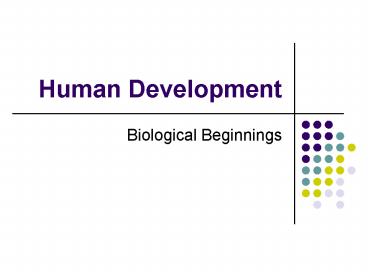Human Development - PowerPoint PPT Presentation
1 / 32
Title:
Human Development
Description:
Human Development Biological Beginnings The Evolutionary Perspective Charles Darwin: The Origin of Species Natural selection: genes which have survival value will be ... – PowerPoint PPT presentation
Number of Views:177
Avg rating:3.0/5.0
Title: Human Development
1
Human Development
- Biological Beginnings
2
The Evolutionary Perspective
- Charles Darwin The Origin of Species
- Natural selection genes which have survival
value will be more abundant in the next
generation - Survival of the fittest individuals who survive
are better adapted - Those who survive reproduce and pass on their
characteristics to the next generation
3
The Evolutionary Perspective
- Evolutionary psychology emphasizes adaptation,
reproduction, and survival of the fittest in
shaping behavior - Using evolutionary principles to explain human
behavior
4
Evolutionary Psychology
- Argument evolution shapes decision making,
aggression, fears, mating/sexual behavior - gene centered perspective
- epigentic perspective
- Critique deterministic downplays the role of
culture and the environment
5
Chromosomes
- We start as a single cell, consisting of our
entire genetic code - Chromosomes located in the nucleus threadlike
structures that carry our genes - We have 46 chromosomes or 23 pairs
- 23 from mother, 23 from father
- The 23rd pair determines our sex
6
Genes and DNA
- Genes unit of hereditary information, composed
of DNA each gene has its own function and
location - DNA contains genetic information and instructions
7
Cells, Chromosomes, Genes, and DNA
Nucleus (center of cell) contains chromosomes and
genes
Chromosomes are threadlike structures composed of
DNA molecules
Gene a segment of DNA (spiraled double chain)
containing the hereditary code
Fig. 2.3
8
Polygenetic Inheritance
- Polygenetic Inheritance when many genes interact
to influence a characteristic - Few behavioral traits are due to just one gene
9
Genes
- Human Genome Project
- Humans have 20,000-25,000 genes
- All humans genes are 99 the same
- Humans and apes share 96-98 of their genes
10
Nature vs. Nurture
- Nature the role of genes
- Nurture the role of the environment and external
conditions - Interactionist Perspective/Epigenetic View
Both nature and nurture are important to
development
11
Childhood AggressionThe Role of Nurture
(Garbarino, 2005)
- RISK FACTORS
- PROTECTIVE FACTORS
- Poverty
- Abuse
- Parental abandonment
- Large family size
- Parental addiction
- Experiencing racism
- Low educational attainment
- Spiritual emptiness
- Positive adult role models
- Intellectual achievement
- Reading for pleasure
- Playing an instrument
- Positive communication with parents
- Spirituality
- Believing we control our fate
12
Childhood Aggression The Role of Nature
- Nature
- Genetic Predisposition
- Abnormal MAOA gene
13
How Nature and Nurture Work Together
- Will a genetic predisposition for a certain
behavioral trait lead to the expression of that
trait? - Answer it depends.
14
How Nature and Nurture Work Together
- Environmental influences (nurture) determine
whether or not the gene is turned on - Genes are NOT destiny
15
Epigenetic/Interactionist Perspective
- Development is the result of an ongoing,
bidirectional interchange between heredity and
environment
16
Behavioral Genetics
- A field that looks at the influence of heredity
and environment - Twin studies comparing identical and fraternal
twins - Adoption studies are children more similar to
the biological or adoptive parent?
17
Behavioral GeneticsLimitations of Twin Studies
- Shared the environments siblings have in common
(i.e. the household) - Non-Shared influences outside the house peer
groups, differential parental treatment, events
experienced at school, etc. - The role of environments
18
Behavioral GeneticsLimitations of Adoption
Studies
- Similarities between adoptive and biological
parents - Children may be placed in similar families
19
Niche-picking
- Niche-picking when children seeks out the
environments they find appealing driven by their
genes - Example a child may inherit a trait like
extraversion he/she will seek out highly social
environments.
20
Genetic Disorders
- Down syndrome
- Extra copy of chromosome 21
- Very young mother or mothers over age 38 at
greater risk
21
Sex-Linked Chromosome Abnormalities
22
The Course of Prenatal Development
- Germinal period 2 weeks after conception
zygote is created, attaches to the uterine wall - Embryonic period 2 to 8 weeks after conception
- Cell layers start to form organs
- Umbilical cord connects to placenta
- Fetal period
- From 2 months after conception to birth
- Trimesters of pregnancy
23
Prenatal Diagnostic Testing
- Amniocentesis samples amniotic fluid to check
for chromosomal or metabolic disorders - Genetic Counseling to understand a childs risk
for inheriting a genetic disorders
24
Teratogens
- Teratogen agents that cause birth defects
- Severity of damage affected by
- Dose
- Genetic susceptibility
- Time of exposure
25
Teratogens
- Heavy drinking fetal alcohol syndrome (FAS)
Facial deformities, low birth weight, respiratory
problems - Nicotine preterm births, low birth weight,
respiratory problems, increased risk of SIDS - Cocaine reduced birth weight, length, and head
circumference - Heroin behavioral problems, tremors, disturbed
sleep, excessive crying, irritability - Methamphetamine low birth weight, developmental
and behavior problems
26
Teratogens
- Environmental hazards
- Lead
- Radiation
- Pesticides
- Carbon minoxide
- Mercury
- PCBs
- Infectious diseases
- AIDS
- STDs
27
Other Parental Factors
- Nutrition
- Children born to malnourished mothers are more
likely to be malnourished/low birth weight - Maternal Age
- Children born to adolescent mothers often
premature, mortality rate is twice that of
mothers in their twenties - Mothers over 35 higher risk of infants with low
birth weight or Down Syndrome
28
Other Parental Factors
- Emotional States/Stress Physiological changes
affecting a mother during times of stress are
transmitted to the fetus - Mothers under stress are 4xs more likely to
deliver early - Stress puts mothers at risk for unhealthy
behaviors - Irregular contractions/difficult labor
29
Low birth weight
- Low brain weight and risk of brain injury
- Lung and liver disease
- ADHD and learning problems/disabilities
- Breathing problems and asthma
- Lower achievement levels
- Some effects can be reversed
30
Apgar Scale
- A scale used to assess the health of a newborn
1-5 minutes after birth - Measures heart rate, respiratory effort, muscle
tone, body color, reflexes (2pts per category) - Total score 7-10 indicates good condition 5
indicates possible developmental difficulties 3
or below signals an emergency
31
The Apgar Scale
Fig. 2.14
32
Bonding
- Needs to occur shortly after birth
- Early emotional attachments may create healthy
interactions after leaving hospital - Massages and tactile stimulation for premature
infants affect development - Research indicates that massage is particularly
helpful for low birth weight infants































